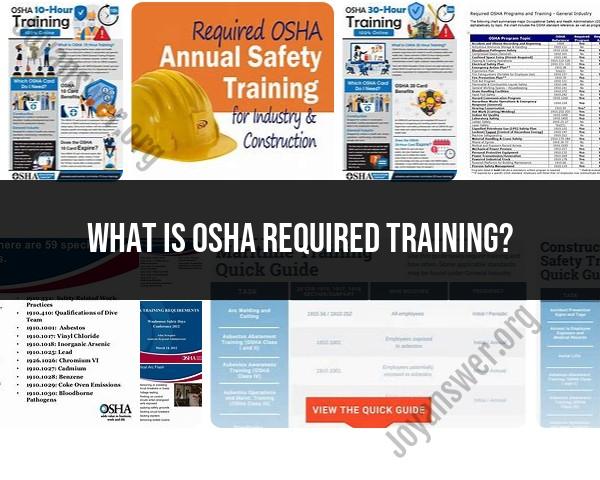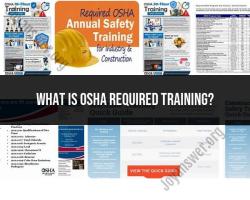What is OSHA required training?
OSHA-required training refers to the training programs and initiatives mandated by the Occupational Safety and Health Administration (OSHA) in the United States. OSHA sets standards to ensure safe and healthful working conditions for employees in various industries. The required training covers a range of topics related to workplace hazards and safety measures.
The essential components of OSHA-required training may vary depending on the specific OSHA standard applicable to a particular industry or workplace. However, some common elements are often included in OSHA-required training programs. Here are key components:
Hazard Awareness and Recognition:
- Training typically covers the identification and recognition of workplace hazards. This may include physical hazards, chemical hazards, biological hazards, ergonomic hazards, and other potential dangers specific to the industry.
Regulatory Overview:
- Employees are educated about the OSHA standards relevant to their work. This includes an overview of the Occupational Safety and Health Act, the General Duty Clause, and specific regulations applicable to their industry.
Specific OSHA Standards:
- Training addresses the specific OSHA standards applicable to the workplace. For example, if the workplace involves exposure to hazardous chemicals, employees may receive training on the Hazard Communication Standard (HazCom).
Safety Procedures and Protocols:
- Employees learn the proper safety procedures and protocols relevant to their tasks. This may include lockout/tagout procedures, emergency evacuation plans, fire safety measures, and other specific safety protocols outlined by OSHA standards.
Personal Protective Equipment (PPE):
- Training covers the proper selection, use, and maintenance of personal protective equipment required for the job. This includes information on when and how to use PPE to mitigate workplace hazards.
Emergency Response:
- Employees receive training on emergency response procedures, such as first aid, cardiopulmonary resuscitation (CPR), and evacuation plans. This is particularly important in industries where the potential for accidents or emergencies exists.
Recordkeeping and Reporting:
- Training may include information on OSHA recordkeeping requirements and the reporting of workplace injuries and illnesses. Employers and employees need to understand how to maintain accurate records and report incidents to OSHA as required.
Employee Rights and Responsibilities:
- Employees are educated about their rights under OSHA, including the right to a safe workplace and the right to report unsafe conditions without fear of retaliation. They also learn about their responsibilities in maintaining a safe work environment.
Supervisor and Management Training:
- OSHA may require training for supervisors and managers to ensure they understand their roles in promoting workplace safety, enforcing safety procedures, and addressing employee concerns.
It's important to note that the specific components of OSHA-required training can vary based on the industry, the type of work being performed, and the hazards present in the workplace. Employers are responsible for identifying and providing training based on the OSHA standards applicable to their operations. Regular updates to training programs may be necessary to ensure compliance with any changes in OSHA regulations. Additionally, employees should receive initial training and periodic refresher training as needed.
Demystifying OSHA-Required Training: A Deep Dive
- Scope of OSHA-Required Training:
OSHA-required training encompasses a wide range of topics intended to protect workers from various hazards and ensure they can work safely and healthily. While not all standards mandate training, many do, covering aspects like:
- Specific job tasks and hazards: For example, training on operating machinery, handling hazardous materials, or working in confined spaces.
- Emergency procedures: Evacuation plans, fire safety, response to spills or leaks.
- Personal protective equipment (PPE): Proper selection, use, and maintenance of PPE relevant to the job.
- Bloodborne pathogens and infectious diseases: Recognizing risks, safe work practices, and exposure prevention.
- Ergonomics and musculoskeletal disorders: Preventing injuries from lifting, repetitive motions, and other work-related postures.
- General workplace safety: Recognizing common hazards, reporting unsafe conditions, and maintaining a safe environment.
- Contribution to Workplace Safety and Compliance:
OSHA-mandated training plays a crucial role in:
- Preventing accidents and injuries: Equipping workers with the knowledge and skills to identify and avoid hazards, reducing risks significantly.
- Promoting safety culture: Building awareness of safety procedures and responsibilities fosters a positive safety culture within the workplace.
- Ensuring compliance: Proper training helps companies comply with relevant OSHA regulations, avoiding potential fines and legal repercussions.
- Improving productivity: A safe and healthy work environment reduces downtime due to accidents and injuries, boosting overall productivity.
- Specific Topics Covered:
The specific topics covered in OSHA-required training programs vary greatly depending on the relevant standard and industry. However, some common themes include:
- Hazard recognition and identification: Learn to recognize and assess potential hazards in the workplace environment.
- Safe work practices and procedures: Understand and follow specific protocols for working safely with equipment, materials, and processes.
- Emergency preparedness and response: Train on evacuation plans, fire safety procedures, and appropriate actions in case of accidents or incidents.
- Recordkeeping and documentation: Understand procedures for reporting hazards, incidents, and near misses.
- Employee rights and responsibilities: Know your rights regarding workplace safety and how to raise concerns about unsafe conditions.
- Consequences of Non-Compliance:
Non-compliance with OSHA-required training regulations can have significant consequences, including:
- Fines and penalties: OSHA can impose substantial fines for violations, depending on the severity and repeated instances.
- Legal action: In serious cases, criminal charges may be filed against employers for willful negligence that directly results in worker harm.
- Negative impact on company reputation: Non-compliance can damage a company's image and lead to a loss of trust from employees, customers, and the public.
- Increased risk of accidents and injuries: Lack of proper training puts workers at higher risk of accidents and injuries, leading to additional costs and productivity losses.
- Industry-Specific Variations:
Yes, there are significant variations in OSHA-required training across different industries. Some examples:
- Construction: Training requirements cover topics like fall hazards, scaffolding safety, and electrical safety.
- Healthcare: Training focuses on bloodborne pathogens, safe handling of medical waste, and emergency procedures.
- Manufacturing: Training addresses specific machinery operation, chemical safety, and confined space entry procedures.
- Agriculture: Training covers tractor safety, handling pesticides, and working with animals.
Companies must identify the relevant OSHA standards applicable to their industry and ensure their training programs align with the specific requirements for their employees' activities.
Remember, OSHA-required training is not simply a regulatory obligation; it's a vital investment in protecting worker safety and well-being, promoting a positive safety culture, and ensuring compliance with legal requirements. By prioritizing proper training, companies can create a safer workplace and reap the benefits of a more productive and efficient workforce.







